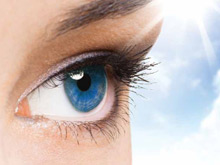Health Topics
-
Healthy Living
-
|
|
May 2012
|
| Light Effects On Eye |
| Dr Aashish K Bansal |
| |
 |
Light is the most valuable gift of nature to living beings. While sun and fire are the natural sources of light, man has also been able to create or produce light artificially by means of incandescent lamps or fluorescent lamps. |
Sunlight or natural light consists of visible spectrum, ultraviolet light and infrared spectrum. Visible light includes the rainbow colours - violet, indigo, blue, green, yellow, orange and red. The UV spectrum consists of UV-A, UV-B and UV-C rays. The infrared spectrum consists of wavelengths greater than 750 nm.
Of these, the visible spectrum and infrared components don’t have much harmful effects. The ultraviolet component however has both specific positive and negative effects on the eyes. UV-B and UV-C are particularly harmful for the eye. Much of the UV-C spectrum is absorbed by the atmosphere and doesn’t reach the eye and the eye itself absorbs part of the UV-B spectrum.
In artificial lighting, incandescent light consists mainly of the visible spectrum. This light is produced as a result of heating filament. The other and the more popular artificial source of light is fluorescent lamp; its spectrum contains very high amounts of UV rays. It also gives more brightness than incandescent light; however, its brightness matches just 10 per cent of the brightness of sunlight.
Seeing Harm
Ironic as it seems, light, while being the whole essence of the human eye and its vision, also brings in its share of ill effects. The harmful effects of light on the eye can be considered in two situations: In normal circumstance due to chronic exposure and in abnormal circumstances, due to acute exposure.
Chronic Exposure:
- It has been seen that people who spend more time in the sun, either because of the nature of their profession or other factors, develop cataract at a much younger age.
- These people are also more prone to develop fleshy growth on the eye surface called as Pterygium.
- Macular degeneration is another very serious vision impairing problem that occurs due to chronic exposure to UV-B and blue wavelength of the light.
Acute Exposure:
- Ordinary sunlight, when reinforced by reflection of light from surfaces like snow or sea or desert, can lead to severe damage of the corneal surface because of UV rays. The affected person develops redness, watering, photophobia and ulcers on the surface of the cornea. This is known as snow blindness.
- Similarly, if one looks directly into the sun for even a fraction of a second, it can lead to burning or damage to the macula - the area where the image forms in the eye. This typically happens during a solar eclipse, as in the normal condition it is impossible to look at the sun directly. The same can happen if one happens to look at a source of strong light like welder’s arc.
- Apart from these serious conditions, minor problems like glare and sensitivity to light or ocular fatigue can occur on prolonged viewing of LED or computer screens or with improper lighting at the work place.
"No bright light should fall on the computer screen directly."
|
Sheild And Shade
- Always wear UV blocking sunglasses when out in the sun.
- Always use UV blocking sunglasses when holidaying – whether you are lazing on a beach, skiing on mountain slopes or striking a trail in a desert. Remember, all sunglasses are not UV blocking.
- Never attempt to view a solar eclipse without proper UV protection glasses.
- Never look in the direction of a welding arc.
- Never get confined indoors for days together. It is good to get exposure to natural light for some time everyday, like during a morning walk or an outdoor sport. Similarly, always switch off the lights and draw curtains while sleeping. That way the dark and light cycle will keep your biorhythms well tuned.
- When at work before a computer screen or watching TV, take breaks in between for a few minutes after every half an hour and look away from the screen.
- Use anti-glare glasses while working on computer or while driving at night.
- There should be uniform lighting at your work place. An illumination of about 500 lux is sufficient for workstations and offices.
- No bright light should fall on the computer screen directly.
- Allow natural light to come in your homes and offices, as much as possible.
- Use fluorescent lamps with double protection film.
|
|
| Dr Aashish k Bansal is Hod & Senior Consultant OphThalmologist,Apollo Health City, Hyderabad |
|
|